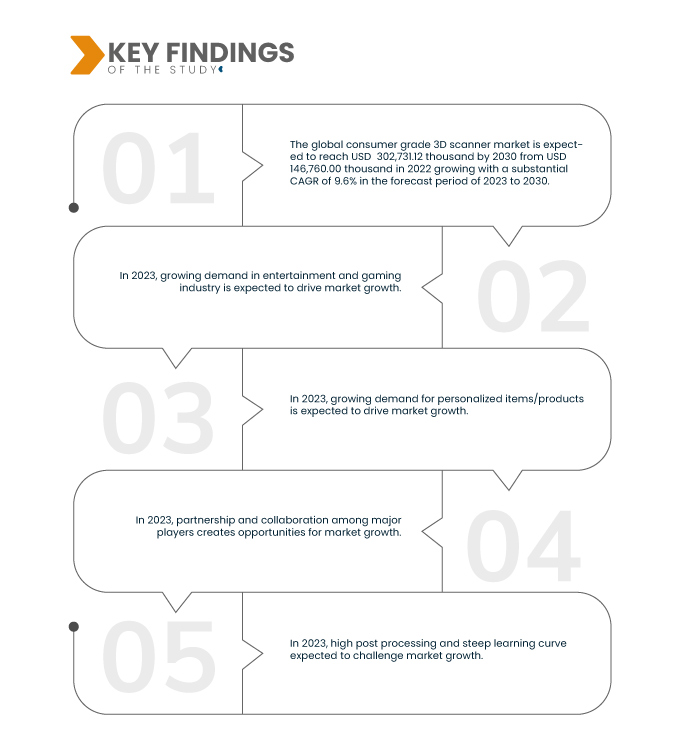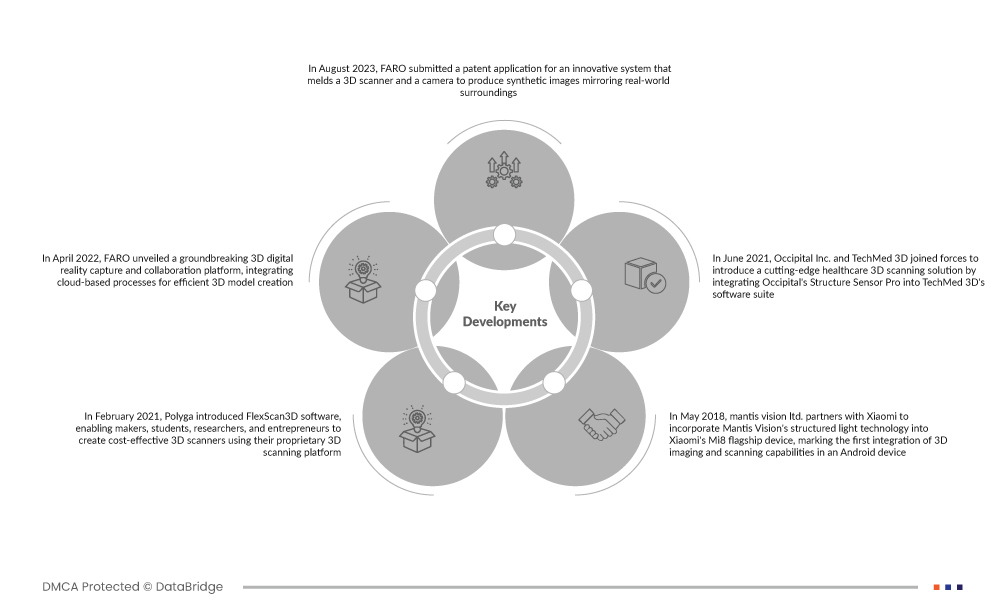A consumer grade 3D scanner is a device designed for everyday individuals and hobbyists to create three-dimensional digital representations of physical objects. These scanners utilize various technologies, such as lasers or structured light, to capture the shape, texture, and intricate details of objects. Different industrial-grade scanners used in professional settings, consumer-grade 3D scanners are tailored for user-friendliness, affordability, and accessibility. They often connect to computers or smartphones, allowing users to easily transfer the scanned data and manipulate it using software to create 3D models for personal projects, artistic endeavors, or even basic design and prototyping tasks. These scanners cater to individuals who are interested in exploring the world of 3D scanning without the complexity or high cost associated with professional-grade equipment.
Access Full Report @ https://www.databridgemarketresearch.com/ko/reports/global-consumer-grade-3d-scanner-market
Consumer grade 3D scanners primarily target enthusiasts, educators, artists, and small-scale designers who seek to harness the power of 3D technology for creative or practical purposes. These scanners are typically used for capturing objects of moderate complexity, such as figurines, sculptures, jewelry, and other items of interest. Consumer-grade 3D scanners contribute to democratizing 3D technology, empowering individuals to bring physical objects into the digital realm for various personal and artistic endeavors.
Data Bridge Market Research analyses that the Global Consumer Grade 3D Scanner Market is expected to reach USD 302,731.12 thousand by 2030 from USD 146,760.00 thousand in 2022 growing with a substantial CAGR of 9.6% in the forecast period of 2023 to 2030.
Key Findings of the Study
Growing Demand in Entertainment and Gaming Industry is expected to Drive Market Growth
Consumer-grade 3D scanners have become more affordable due to advancements in sensor technology, manufacturing processes, and economies of scale. This reduction in cost has broadened the market's reach beyond professional and industrial, making 3D scanning accessible to hobbyists, students, and small businesses. They find utility in various fields such as 3D printing, augmented reality/virtual reality (AR/VR) content creation, art, education, and even healthcare. The ability to create personalized 3D models for products, gifts, and keepsakes is appealing to consumers. The diversification of applications is attracting a broader user base, contributing to market growth.
Report Scope and Market Segmentation
|
Report Metric
|
Details
|
|
|
Forecast Period
|
2023 to 2030
|
|
|
Base Year
|
2022
|
|
|
Historic Years
|
2021 Customizable into (2015-2020)
|
|
|
Quantitative Units
|
Revenue in USD Thousand
|
|
|
Segments Covered
|
Offering (Hardware, Software & Solutions, and Services), Range (Short-Range 3D Scanners, Medium-Range 3D Scanners), Type (Structured Light Scanners, 3D Laser Scanners, and Hybrid 3D Scanners), Technology (Light Triangulation, Laser Triangulation, Pattern Fringe Triangulation, and Laser Pulse Based), Application (Quality Control/Inspection, Reverse Engineering, Virtual Simulation, and Others), Product (Handheld, Tripod Mounted, and Desktop), End-Use (Additive Printing, Architects and Designers, Education and Research, Hobbyists, Arts, and Digital Content Creation and Others)
|
|
|
Region Covered
|
U.S., Canada, Mexico, Germany, U.K., France, Spain, Italy, Netherlands, Russia, Switzerland, Belgium, Turkey, Rest of Europe, China, Japan, South Korea, India, Malaysia, Australia, Singapore, Indonesia, Thailand, Philippines, Rest of Asia-Pacific, Brazil, Argentina, Rest of South America, South Africa, Saudi Arabia, U.A.E., Egypt, Israel, and Rest of Middle East and Africa
|
|
|
Market Players Covered
|
Matter and Form, Inc. (Canada), CREAFORM (Canada), Artec Europe (Luxembourg), SHINING 3D (China), FARO (U.S.), Occipital Inc. (U.S.), Scan Dimension (A subsidiary of Global Scanning A/S Group) (Denmark), XYZprinting, Inc. (As a subsidiary of Nexa3D) (Taiwan), Revopoint 3D Technologies Inc. (China), Shenzhen Creality 3D Technology Co., Ltd. (China), SCANTECH (HANGZHOU) CO. LTD.(China), Polycam (U.S.), Openscan (Germany), THOR3D (Russia), Polyga (Canada), EyeCue Vision Technologies LTD. (Israel), Scandy Co. (U.S.), Beijing Xunheng Technology Co., LTD (Thunk3D) (China), mantis vision ltd. (Israel), EPIC GAMES, INC.(U.S.)
|
|
|
Data Points Covered in the Report
|
In addition to the insights on market scenarios such as market value, growth rate, segmentation, geographical coverage, and major players, the market reports curated by the Data Bridge Market Research also include in-depth expert analysis, pipeline analysis, and regulatory framework.
|
|
Segment Analysis
The global consumer grade 3D scanner market is segmented into seven notable segments which are on the basis of offering, range, type, technology, application, product, and end-use.
- On the basis of offering, the market is segmented into hardware, software & solutions, and services.
In 2023, hardware segment is expected to dominate the global consumer grade 3D scanner market
In 2023, hardware segment is expected to dominate the global consumer grade 3D scanner market by advancements in sensor technology, optics, and image processing have led to higher accuracy, improved resolution, and faster scan speeds with 47.94% market share.
- On the basis of range, the market is segmented into short-range 3D scanners and medium-range 3D scanners. In 2023, short-range 3D scanners segment is expected to dominate the global consumer grade 3D scanner market with 86.53% market share.
- On the basis of type, the market is segmented into structured light scanners, 3D laser scanners, and hybrid 3D scanners. In 2023, structured light scanners segment is expected to dominate the global consumer grade 3D scanner market with 47.92% market share.
- On the basis of technology, the market is segmented into light triangulation, laser triangulation, pattern fringe triangulation, and laser pulse based. In 2023, light triangulation segment is expected to dominate the global consumer grade 3D scanner market with 46.40% market share.
- On the basis of application, the market is segmented into quality control/inspection, reverse engineering, virtual simulation, and others. In 2023, quality control/inspection segment is expected to dominate the global consumer grade 3D scanner market with 43.34% market share.
- On the basis of product, the market is segmented into handheld, tripod mounted, and desktop. In 2023, handheld segment is expected to dominate the Global consumer grade 3D scanner market with 53.00% market share.
- On the basis of end-use, the market is segmented into additive printing, architects and designers, education and research, hobbyists, arts and digital content creation, and others.
In 2023, additive printing segment is expected to dominate the global consumer grade 3D scanner market
In 2023, additive printing segment is expected to dominate the global consumer grade 3D scanner market by facilitating the creation of accurate digital models that serve as the basis for 3D printing, enabling users to reproduce physical objects with precision with 31.49% market share.
Major Players
Data Bridge Market Research recognizes the following companies as the Some of the major market players operating in the market are Matter and Form, Inc. (Canada), CREAFORM (Canada), Artec Europe (Luxembourg), SHINING 3D (China), FARO (U.S.), Occipital Inc. (U.S.), Scan Dimension (A subsidiary of Global Scanning A/S Group) (Denmark), XYZprinting, Inc. (As a subsidiary of Nexa3D) (Taiwan), Revopoint 3D Technologies Inc. (China), Shenzhen Creality 3D Technology Co., Ltd. (China), SCANTECH (HANGZHOU) CO. LTD.(China), Polycam (U.S.), Openscan (Germany), THOR3D (Russia), Polyga (Canada), EyeCue Vision Technologies LTD. (Israel), Scandy Co. (U.S.), Beijing Xunheng Technology Co., LTD (Thunk3D) (China), mantis vision ltd. (Israel), EPIC GAMES, INC.(U.S.).
Market Development
- June 2023, Scan Dimension the SOL 3D scanner consistently garners praise as a top-tier option in its price range, lauded for its remarkable scanning prowess. Initially spotlighting technical specs and user expectations upon its 2019 launch, it now gains recognition for its affordability and user-friendly nature, serving as a flexible and attainable 3D scanning solution. Esteemed evaluations from diverse sources underscore SOL's quality and value, positioning it as the favored pick for dependable 3D scanning encounters by enthusiasts and professionals similarly.
- In August 2023, FARO submitted a patent application for an innovative system that melds a 3D scanner and a camera to produce synthetic images mirroring real-world surroundings. By fusing data from the 3D scanner's point cloud and the camera's images, the system generates accurate, position-independent depictions of the environment. This strategic move highlights Faro's pioneering approach within the industry.
- In June 2021, Occipital Inc. and TechMed 3D joined forces to introduce a cutting-edge healthcare 3D scanning solution by integrating Occipital's Structure Sensor Pro into TechMed 3D's software suite.
- In February 2021, Polyga introduced FlexScan3D software, enabling makers, students, researchers, and entrepreneurs to create cost-effective 3D scanners using their proprietary 3D scanning platform.
- In May 2018, mantis vision ltd. partners with Xiaomi to incorporate Mantis Vision's structured light technology into Xiaomi's Mi8 flagship device, marking the first integration of 3D imaging and scanning capabilities in an Android device.
Regional Analysis
Geographically, the countries covered in the global consumer grade 3D scanner market report are U.S., Canada, Mexico, Germany, France, U.K, Italy, Spain, Netherlands, Russia, Switzerland, Turkey, Austria, Norway, Hungary, Lithuania, Ireland, Poland, Rest of Europe, China, Japan, India , South Korea, Australia, Singapore, Thailand, Malaysia, Indonesia, Philippines, Vietnam, Rest of Asia-Pacific, Brazil, Argentina, Peru, Rest of South America, South Africa, Saudi Arabia, U.A.E., Egypt, Israel, Kuwait, and Rest of the Middle East and Africa.
As per Data Bridge Market Research analysis:
North America is estimated to be the dominating region in the Global Consumer Grade 3D Scanner Market
North America region is expected to dominate the market as the region has a strong focus on technological advancements and innovation, particularly in sectors such as aerospace, defense, and emergency response. This technological prowess enables North America companies to develop and offer cutting-edge search and rescue equipment that meets the evolving needs of the market.
Asia Pacific is the fastest growing region in the Global Consumer Grade 3D Scanner Market
Asia Pacific is the fastest growing region in the global consumer-grade 3D scanner market, due to its innovation-driven ecosystem, seamless integration with 3D printing, creative communities, cross-industry applications, supportive policies, education initiatives, industrial demand, cultural preservation efforts, and access to funding.
For more detailed information about the global 3D scanner market report, click here – https://www.databridgemarketresearch.com/ko/reports/global-consumer-grade-3d-scanner-market















